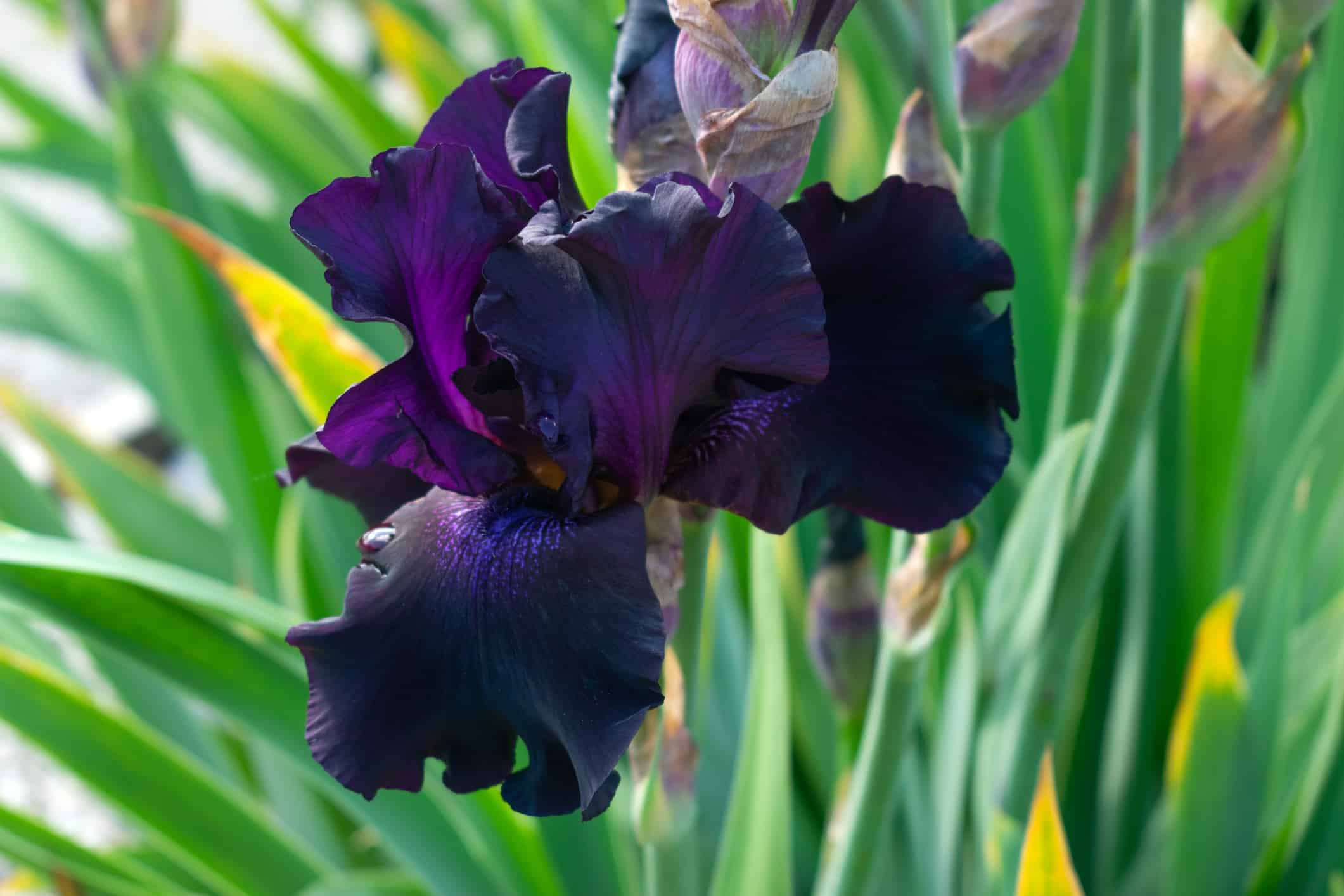In the enchanting world of flora, the iris flower stands as a vibrant testament to nature’s kaleidoscope of colors. These botanical marvels, with their striking blooms and unique hues, have captured the hearts of garden enthusiasts and artists alike. In this article, we embark on a colorful journey through the captivating spectrum of iris flowers.
1. Apricot

The apricot iris petals often have additional colors, such as purple (pictured).
©yuelan/iStock via Getty Images
Apricot irises, with their distinctive hue that falls somewhere between a soft orange and a pale pink, captivate with their unique coloration. This specific shade is the result of a combination of pigments and genetics. The presence of carotenoid pigments, such as beta-carotene, gives apricot irises their warm, inviting color. These pigments interact with the iris’s underlying genetics, producing a range of shades, from a delicate apricot to a deeper, more intense hue.
Symbolically, apricot irises convey a message of enthusiasm, creativity, and a zest for life. Their color is often associated with warmth, joy, and energy. The apricot iris represents a burst of inspiration and a sense of adventure. It is a symbol of embracing new opportunities with an open heart and a positive outlook. This vibrant color suggests a desire to take action, explore new horizons, and approach life’s challenges with optimism.
In the language of flowers, apricot irises are like a cheerful reminder to seize the day and embrace the beauty of the present moment. Their specific coloration adds a touch of uniqueness to any garden or floral arrangement. Their color makes them a delightful choice for those seeking to convey these sentiments through nature’s palette.
2. Black

The black irises are usually just a very dark violet or blue hue.
©MalikaMisirpashaeva/iStock via Getty Images
Black irises, with their mysterious and alluring color, are a captivating marvel of nature. While they may appear truly black, they often possess a deep, velvety shade of dark purple, indigo, or maroon, rather than a pure black. This intriguing hue is achieved through a combination of pigments and the way light interacts with the flower.
The color of black irises is primarily attributed to the presence of anthocyanin pigments, particularly delphinidin. These pigments, when highly concentrated, create the intense dark tones seen in these irises. Additionally, the flower’s genetics play a role in regulating the production and distribution of pigments, further influencing its coloration.
Symbolically, black irises are associated with mystery, elegance, and sophistication. They represent a sense of enigma and the unknown. This makes them a favorite choice for adding an element of intrigue to gardens and floral arrangements. This color signifies depth, strength, and resilience, reflecting the ability to overcome challenges and emerge stronger.
Black irises can also symbolize transformation and rebirth. This is because they stand out prominently against other flowers due to their dark shade. In various cultures, they are used to convey a sense of power and prestige. This makes them a timeless and enchanting choice for those seeking to convey depth and sophistication through floral language.
3. Blue
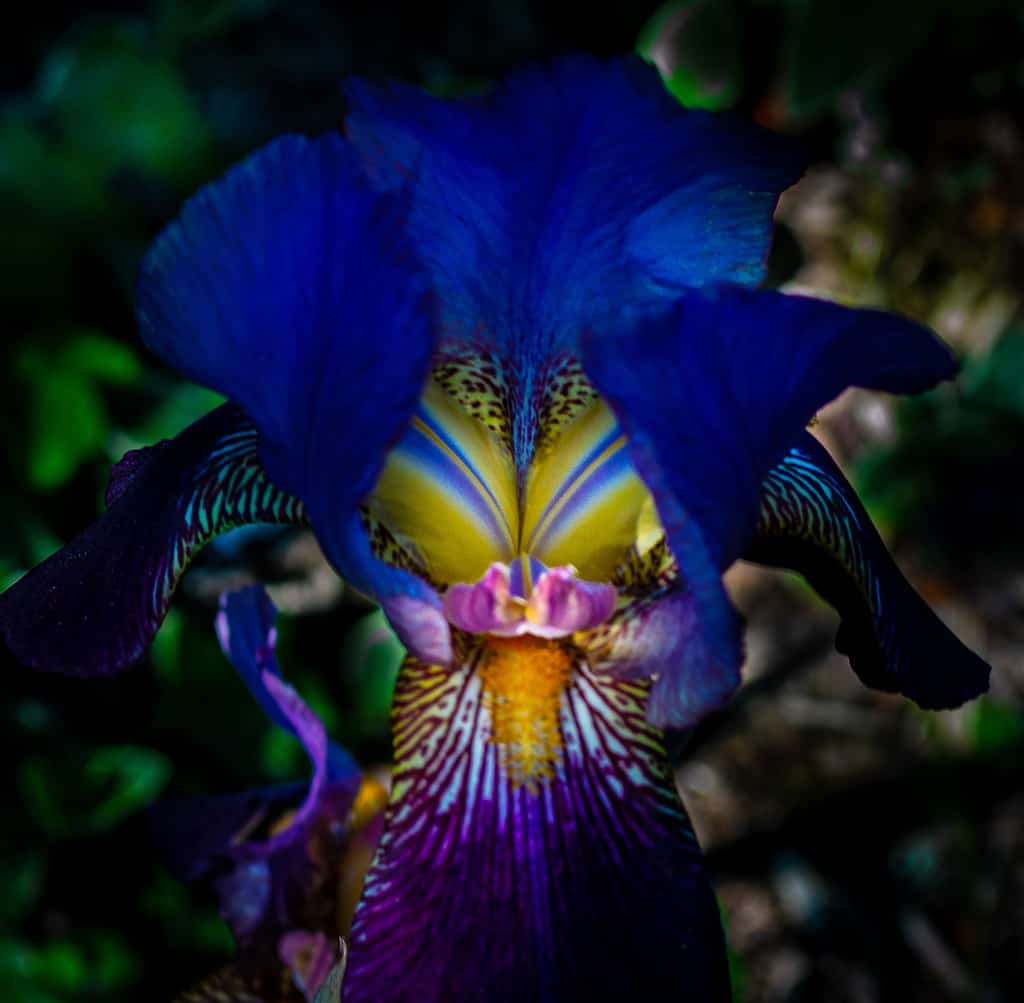
The blue irises are very common and come in a wide range of varieties, such as the Zebra Iris (pictured).
©GSLstudio/iStock via Getty Images
Blue irises are renowned for their serene and captivating color. They owe their specific hue to a fascinating blend of pigments and natural processes. The vibrant blue shades in these flowers are primarily a result of the presence of anthocyanin pigments, particularly malvidin. These pigments are responsible for absorbing wavelengths of light in the red and orange spectrum. This is what gives the iris its characteristic blue appearance.
Symbolically, blue irises represent a variety of emotions and sentiments. They are often associated with calmness, tranquility, and peace. The soothing blue color evokes a sense of serenity and relaxation. This makes blue irises a popular choice for creating peaceful and harmonious garden spaces.
Furthermore, blue irises can symbolize wisdom, hope, and trust. Their color suggests depth and stability, reflecting the notion of steadfastness and fidelity. In some cultures, blue irises are even seen as a symbol of faith and loyalty. This makes them a meaningful choice for expressing these sentiments.
Overall, blue irises carry a versatile symbolism, making them a cherished flower for various occasions. Whether used in floral arrangements or cultivated in gardens, these blooms enchant with their tranquil beauty and the profound emotions they convey through their enchanting blue hue.
4. Cream or White
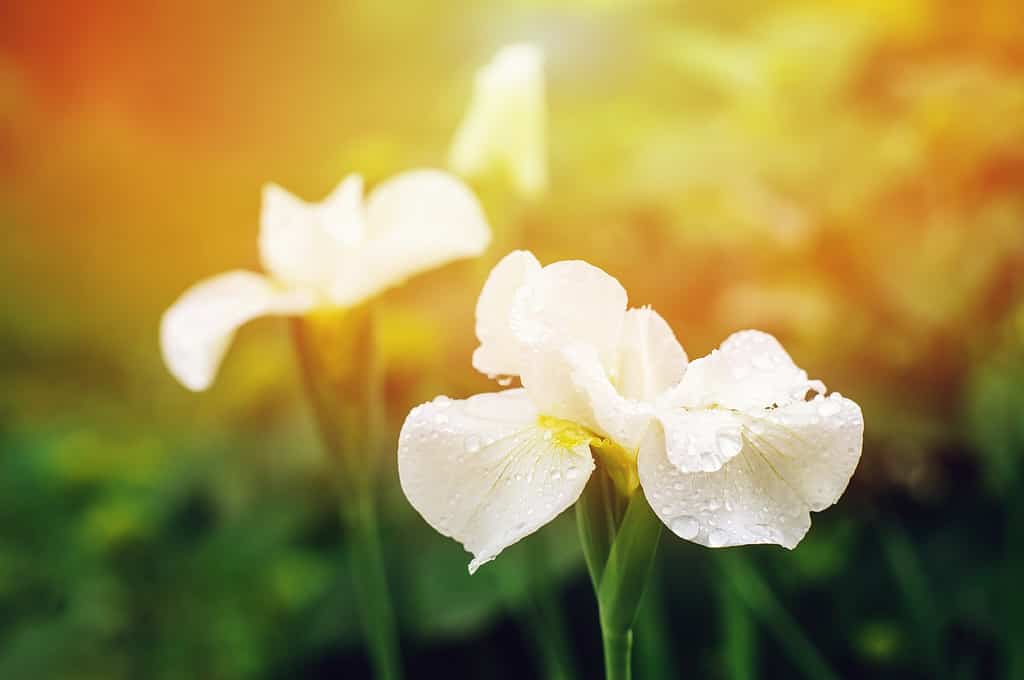
White irises are popular for events like weddings and the birth of a baby.
©Mkovalevskaya/iStock via Getty Images
Cream or white irises, with their delicate and pristine petals, acquire their specific coloration through a combination of natural factors. The primary factor is the absence of pigments called anthocyanins, which are responsible for most flower colors. In the case of cream or white irises, these pigments are either present in minimal quantities or absent. This allows the inherent whiteness or creaminess of the petals to shine through. Additionally, other pigments like flavonoids contribute to the pale coloring, giving the flowers their soft and elegant appearance.
Symbolically, cream and white irises represent purity, innocence, and simplicity. Their color is often associated with purity of heart and a fresh start. These irises convey a sense of clarity, serenity, and peace. This makes them a popular choice for weddings and other special occasions where an atmosphere of grace and purity is desired.
Moreover, cream and white irises can symbolize reverence and respect. They evoke a sense of humility and admiration, signifying the admiration and esteem one holds for another. These irises also symbolize new beginnings, making them a meaningful choice when embarking on a fresh chapter in life.
In gardens and floral arrangements, cream and white irises stand as timeless emblems of elegance and grace. Their understated beauty and symbolism make them a cherished bloom for a variety of occasions.
5. Purple
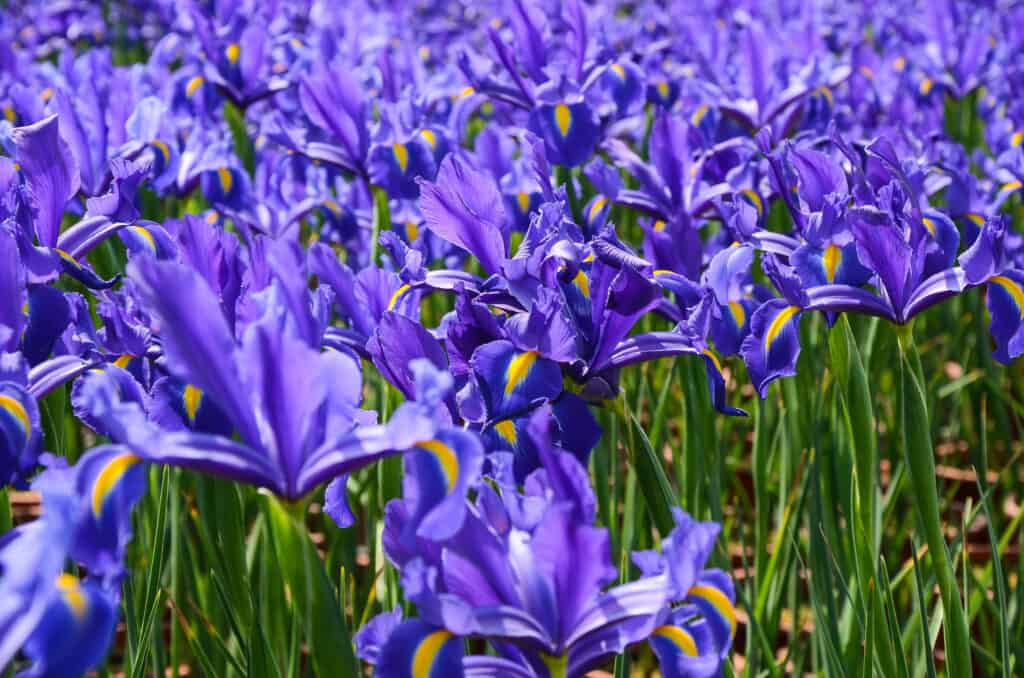
The purple irises are one of the most common irises in the world, and many are found growing in the wild around the world.
©iStock.com/liuyushan
Purple irises have a rich and enchanting color. They derive their distinctive hue from a combination of pigments and genetics. The prominent purple shades in these flowers are primarily attributed to anthocyanin pigments, specifically malvidin. These pigments absorb light in the red and orange spectrum, creating the captivating purples seen in irises. The iris’s underlying genetics also play a role in determining the exact shade of purple. This can range from deep, velvety purples to lighter, more vibrant hues.
Symbolically, purple irises hold diverse meanings. They are often associated with royalty, power, and luxury. The regal shade of purple represents prestige and dignity, making purple irises a popular choice for conveying admiration and respect. This color also signifies creativity and artistic expression, reflecting a sense of imagination and individuality.
Furthermore, purple irises can symbolize wisdom and serenity. Their color suggests a calm and thoughtful demeanor, making them a suitable gift to convey sentiments of trust and admiration. In some cultures, purple irises are associated with spirituality and inner peace. This makes them an emblem of higher consciousness and understanding.
Overall, purple irises are cherished for their vibrant color and the multitude of emotions and qualities they symbolize. Whether gracing gardens or floral arrangements, these irises captivate with their regal beauty and the profound sentiments they convey through their stunning purple blooms.
6. Orange
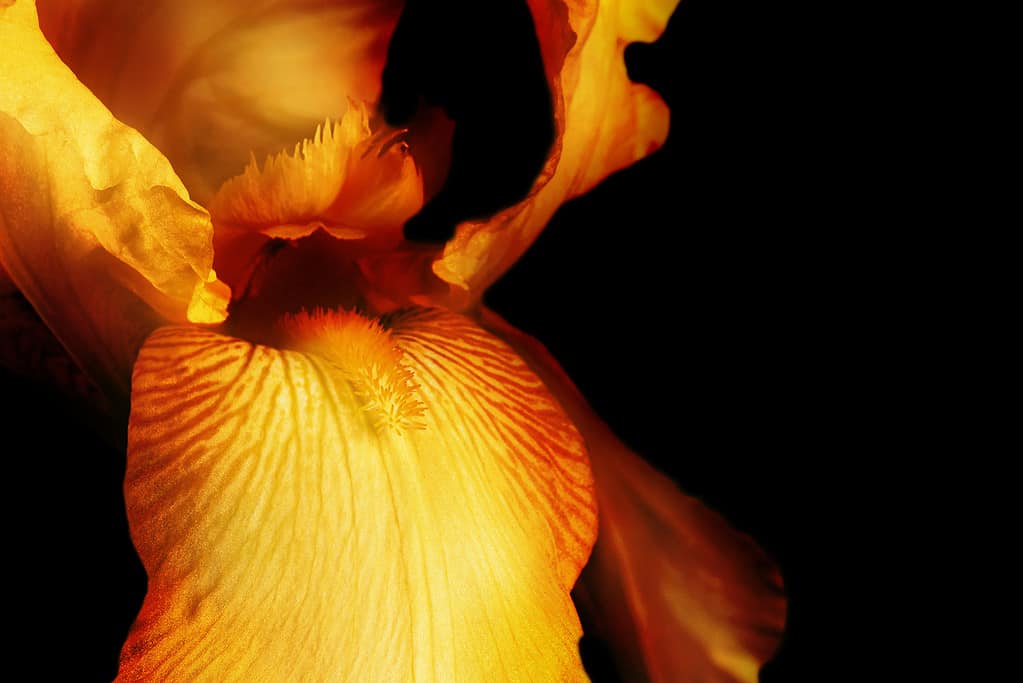
The orange iris is known for symbolizing passion and energy, and they are also one of the rarest colors you’ll find in this flower.
©LarisaL/iStock via Getty Images
Orange irises attain their specific hue through a combination of pigments and natural processes. The striking orange shades in these flowers are predominantly attributed to the presence of carotenoid pigments, notably beta-carotene. These pigments absorb light in the blue and green spectrum while reflecting and transmitting orange hues, giving the iris its distinctive color. The flower’s genetics also influence the intensity and range of orange within the petals.
Symbolically, orange irises represent enthusiasm, energy, and a zest for life. Their lively and warm color evokes a sense of joy and optimism, making them an excellent choice for conveying sentiments of excitement and adventure. Orange irises signify a desire to embrace new opportunities with open arms and a positive outlook.
Furthermore, these irises can symbolize creativity and passion. The bold and dynamic nature of the orange color reflects a spirit of creativity and a spark of inspiration. In various cultures, orange irises are associated with success and achievement, making them a meaningful choice when celebrating accomplishments or embarking on new ventures.
In gardens and floral arrangements, orange irises add a burst of vibrancy and energy, captivating onlookers with their vivacious blooms. They serve as a vivid reminder to seize the day and embrace the beauty of life’s moments with enthusiasm and passion.
7. Pink
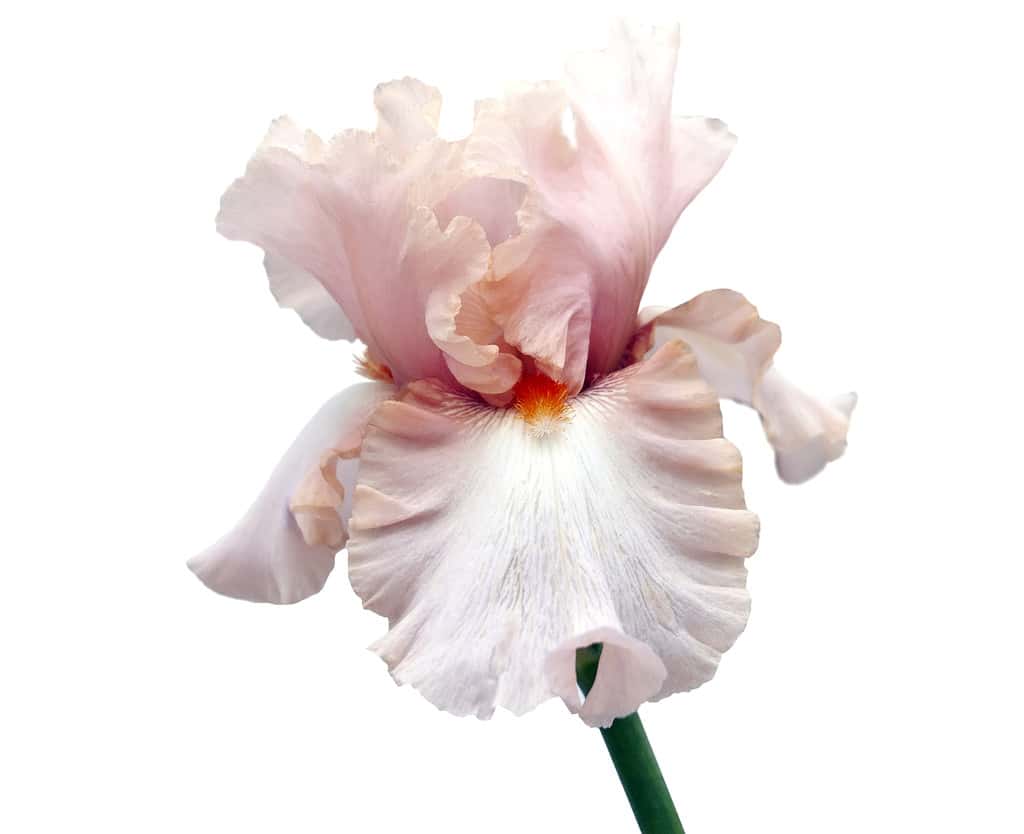
These are a common gesture of love, gentleness, romance, and elegance.
©TatianaMironenko/iStock via Getty Images
Pink irises, renowned for their soft and romantic color, acquire their specific hue through a combination of natural pigments and genetic factors. The charming pink shades in these flowers are primarily due to the presence of pigments called anthocyanins, specifically pelargonidin. These pigments interact with the iris’s genetic makeup to produce a range of pink tones, from delicate pastels to deeper, more vibrant pinks.
Symbolically, pink irises represent love, admiration, and femininity. Their gentle and elegant color evokes feelings of affection and tenderness, making them a cherished choice for expressing love and appreciation. Pink irises symbolize heartfelt emotions, conveying sentiments of admiration and gratitude.
Furthermore, pink irises can symbolize grace and sophistication. The refined and timeless nature of the pink hue reflects a sense of elegance and poise, making them a suitable choice for conveying sentiments of grace and charm. In some cultures, pink irises are associated with happiness and joy, making them a meaningful gift to celebrate moments of happiness and contentment.
In gardens and floral arrangements, pink irises bring a touch of elegance and romance, captivating with their delicate beauty and the heartfelt emotions they convey through their lovely pink blossoms. Whether given as a gesture of love or used to enhance the aesthetics of a space, pink irises continue to be a symbol of affection and grace.
8. Red
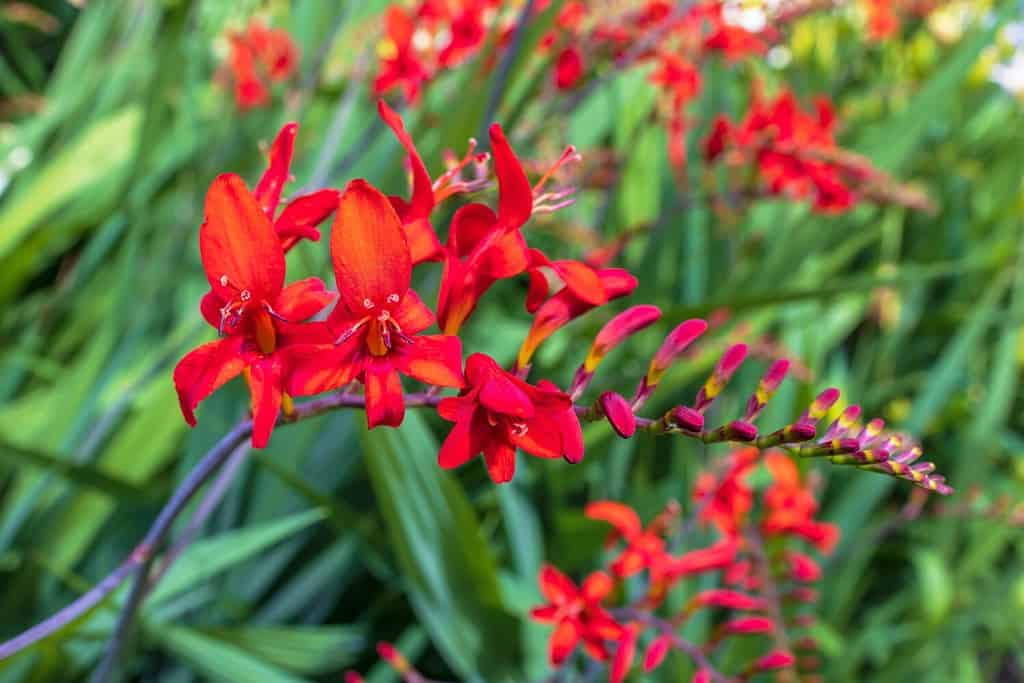
The red irises make an excellent addition to any flower garden due to their striking contrast of color.
©Debu55y/Shutterstock.com
Red irises, with their passionate and intense color, owe their specific hue to the presence of pigments and the genetic makeup of the flower. The vibrant red shades in these irises are primarily a result of anthocyanin pigments, particularly cyanidin. These pigments absorb light in the green and blue spectrum while reflecting red wavelengths, giving the iris its fiery appearance. Additionally, the iris’s genetics play a role in determining the exact shade of red, ranging from deep crimson to brighter scarlet hues.
Symbolically, red irises represent love, desire, and strength. Their bold and striking color evokes feelings of passion and ardor, making them a powerful choice for expressing love and affection. Red irises symbolize deep emotions and convey sentiments of romance and desire.
Furthermore, these irises can symbolize courage and determination. The fiery nature of the red hue reflects a sense of strength and resilience, making them a suitable choice for celebrating achievements and milestones. In various cultures, red irises are associated with energy and vitality, making them a meaningful gift to convey a sense of motivation and inspiration.
In gardens and floral arrangements, red irises command attention with their passionate beauty, standing as symbols of love and determination. Their striking presence and the profound emotions they represent through their vivid red blossoms make them a cherished choice for various occasions.
9. Brown

These irises are quite rare, but their coloration is quite stunning to behold.
©Lenorko/Shutterstock.com
Brown irises, with their earthy and unusual coloration, achieve their specific hue through a combination of pigments and genetic factors. The distinct brown shades in these flowers arise due to the presence of pigments like melanin and anthocyanins, which interact with the plant’s genetics. These pigments absorb and reflect specific wavelengths of light, giving rise to the various brown tones seen in brown irises.
Symbolically, brown irises are associated with stability, grounding, and simplicity. Their natural and earthy color represents a connection to the earth and a sense of rootedness. Brown irises symbolize reliability and steadfastness, conveying sentiments of trust and dependability.
Furthermore, these irises can symbolize humility and a genuine nature. The unpretentious brown hue reflects a sense of authenticity and sincerity, making them a suitable choice for expressing genuine sentiments and gratitude. In some cultures, brown irises are seen as symbols of protection and security, making them a meaningful gift to convey feelings of safety and support.
In gardens and floral arrangements, brown irises stand out with their unique and understated beauty, serving as reminders of the importance of staying grounded and true to oneself. Their natural charm and the profound emotions they represent through their distinctive brown blossoms make them a thoughtful choice for a variety of occasions.
10. Lavender

Lavender-hued irises are quite common, but they still add an element of elegance to bouquets and flower gardens alike.
©iStock.com/Gerald G Gantar
Symbolically, lavender irises represent grace, elegance, and tranquility. Their delicate and serene color evokes a sense of calmness and refinement, making them a cherished choice for conveying sentiments of admiration and appreciation. Lavender irises symbolize feelings of love at first sight, conveying sentiments of enchantment and adoration.
Moreover, lavender irises can symbolize femininity and grace. The gentle and timeless nature of the lavender hue reflects a sense of elegance and charm, making them a suitable choice for expressing sentiments of beauty and grace. In some cultures, lavender irises are associated with royalty and luxury, making them a meaningful gift to convey feelings of admiration and prestige.
In gardens and floral arrangements, lavender irises add a touch of sophistication and tranquility, captivating with their delicate beauty and the profound emotions they convey through their enchanting lavender blossoms. Whether given as tokens of love or used to enhance the aesthetics of a space, lavender irises continue to be symbols of elegance and refinement.
Summary of Different Colors Of Iris Flowers to Liven Up Your Yard + More
| # | Iris Flower Color |
|---|---|
| 1 | Apricot |
| 2 | Black |
| 3 | Blue |
| 4 | Cream or White |
| 5 | Purple |
| 6 | Orange |
| 7 | Pink |
| 8 | Red |
| 9 | Brown |
| 10 | Lavender |
| 11 | Burgundy |
| 12 | Rose |
| 13 | Yellow |
| 14 | Peach |
Thank you for reading! Have some feedback for us? Contact the AZ Animals editorial team.

